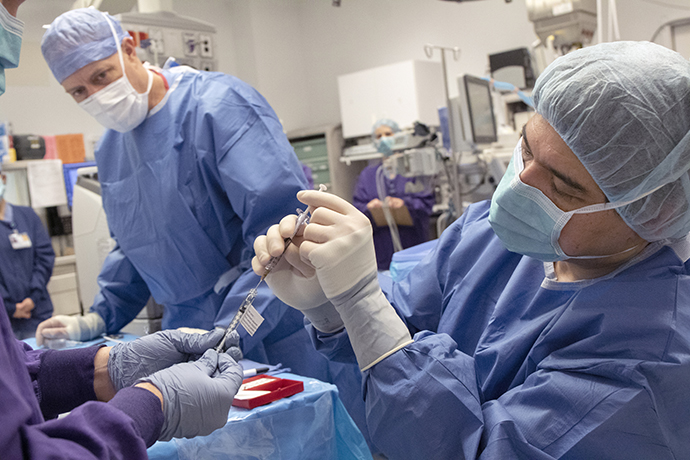
Pioneering the first-ever CRISPR gene editing in vivo
On Feb. 25, 2020, OHSU Casey Eye Institute led a unique moment in human history—the first gene editing procedure in a living person in all of medicine.
As part of the BRILLIANCE clinical trial, the procedure seeks to repair mutations in the CEP290 gene that causes Leber congenital amaurosis type 10 (also known as LCA10 and CEP290-related retinal dystrophy). Andreas K. Lauer, M.D., internationally recognized as one of the leading ocular gene therapy surgeons, performed the operation that edits the mutated gene using CRISPR technology.
“We have the ability to snip out the abnormal DNA in a cell,” he said. “We’re not altering the person’s genetics, only changing the DNA at a molecular level in a very local area of the retina, and not even whole retina, just in a specific functional area and in a deliberate and controlled way. To do this for the first time in a human being— that’s an amazing initial step.”
Mark Pennesi, M.D., Ph.D., who leads OHSU’s involvement in the trial and is the chief of the OHSU Casey Eye Institute’s Paul H. Casey Ophthalmic Genetics Division, said the significance of this first use of CRISPR in vivo has implications beyond ophthalmology.
“Being able to edit genes inside the human body is incredibly profound,” he said. “Beyond potentially offering treatment for a previously untreatable form of blindness, in vivo gene editing could also enable treatments for a much wider range of diseases.”
Patients with Leber congenital amaurosis type 10 can now have hope that treatment will be possible to prevent, halt or reverse blindness for them and their children.
“As we become more comfortable with treating these patients, there will be opportunities to treat younger patients before degeneration occurs and preserve vision at an earlier stage,” Lauer said.
The outlook is changing for previously untreatable retinal dystrophies, Pennesi noted.
“As ophthalmologists, we need to be aware of the evolving opportunities for these patients,” he said. “We are entering an era of new therapy for those who otherwise would become irreversibly blind. For the first time, we are offering hope for these patients and their families and improving quality of life.”
The clinical trial sponsored by Allergan/Editas Medicine continues with a second patient scheduled at another eye center. Casey Eye Institute treated the third patient on January 21, 2021 and will continue to participate and enroll patients. “It is a tremendous privilege to be doing this work,” Lauer said. “We are trying to alter the way we practice medicine through innovation.”
An epicenter for ocular gene therapy trials
OHSU Casey Eye Institute has invested in creating ideal conditions for cutting-edge clinical trials by having facilities, staff and technology to push the boundaries of what’s possible. For example, we were one of the first institutions in the country to administer the first federally approved gene therapy for biallelic RPE65 mutation-associated retinal dystrophy. Resources that make this type of cutting-edge treatment possible include:
- Dedicated space in a new 60,000-square-foot building for the Paul H. Casey Ophthalmic Genetics Division, with imaging technology integrated into exam spaces and a mobility maze
- Intraoperative OCT
- Experienced surgical and OR team, which has performed more than 150 ocular gene therapy procedures
- Three ophthalmic geneticists
- Eight clinical trial coordinators
- 14 clinical trials investigating new genetic treatments for ophthalmic conditions
- 50 vision-related clinical trials overall